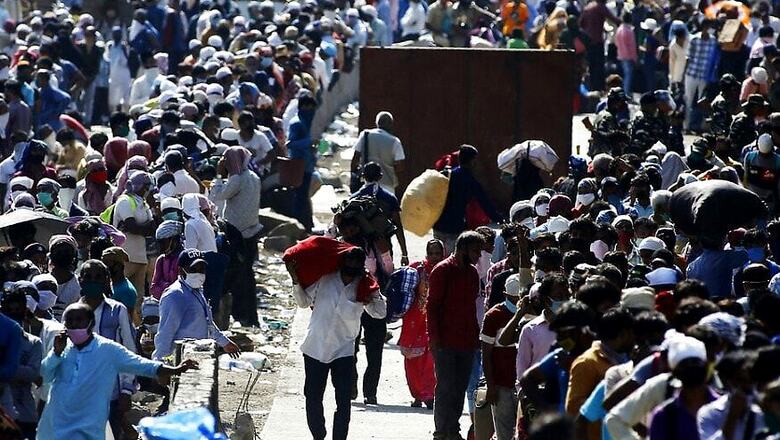
views
Jadab Gogoi, a 46-year-old migrant worker from Assam, was working at Vapi in Gujarat. When the Covid-19 lockdown was announced, Gogoi's livelihood was snatched away by his employer where he was engaged for the past six months. With no resources at hand, he decided to return to Assam, covering a distance of around 2,900 km. Gogoi undertook the journey in 25 days, mostly on foot, with deteriorating health, just lucky enough to have lived to tell his extraordinary tale. In an interview to local press, he said, “But one thing is for sure: never in my life will I step out of Assam again.”
Indian media is full of such stories of migrant workers who have lost their daily livelihood and are making desperate attempts for returning home. There are three aspects of such stories: the need for leaving their native place, their inability to withstand any crisis , and their sentimental urge to come back home as the only attempt to be alive than to search for possibilities in ‘unknown’ land. If we think of solutions towards fostering self-reliance in migrant workers, we need to take care of these three aspects.
Cities are economic hotspots fuelling India’s GDP growth with migrants becoming an inseparable component of the growth story. Migrant workers in urban areas, more often than not, are engaged in informal arrangements of employment, without formal contract, often paid a compensation below minimum wage and lack basic social and health security. Not able to exercise their political right, the voices of these workers are not heard. In a country like India where ancient social system was based on the type of job, these workers often face harassment and mistreatment because of engaging in professions which are often stigmatised (e.g. domestic help, rickshaw pullers, etc). A daunting challenge is to track their whereabouts particularly because of their transient nature, a phenomenon referred to as ‘circular migration’.
Due to the recent crisis, caused by the Covid-19 lockdown, 400 million informal workers in the country are at risk of falling into poverty as reported in the International Labour Organization study titled ‘ILO Monitor: COVID-19 and the world of work (second edition)’. There is no scientific way to estimate the number of migrant workers from this lot. During such crisis, identifying and tracking the movement becomes even more critical to undertake corrective measures.
Crisis, however, brings an opportunity to address legacy issues and prepare an efficient plan for a better tomorrow. After the initial reluctance, the central and state governments have taken several measures to bring back the native citizens who are stuck in different cities: with steps such as conducting health check-ups at the state borders, making formal registers before sending them to quarantine, providing free ration to the families, and so on. This is a welcome step considering the emotional sentiment of migrant workers to be with their dear ones during the crisis.
This may be the right time to create a formal registry or database for India’s large informal workforce to bring it under the umbrella of social security. Since migrant workers are an important subset of this informal workforce, they can be the starting point. The database, envisaged to be backed by the legislature, could be similar to what embassies of India and ministry of external affairs maintains for international migrants. With a user-friendly online interface, this is envisaged not only to be limited to tracking movement of migrant workers but also serving as a repository for those seeking employment, providing ration in a mobile fashion, providing skill-development training, enabling employers to recruit workers matching their required skill sets, among others. All these dimensions constitute the package the finance minister has announced targeting the migrant workers. Let us deep-dive into four important services or functionalities of the proposed initiative that will push the agenda of streamlining the migrant workforce.
Accurate identification resulting in efficient delivery: There is not a single definition of migrant workers and informal wokforce, leave alone an identified registry. This proposed database can include major socio-economic indicators to identify migrant workers to better support policymaking. The aspects of data consent, security and privacy would be integral components. The information should include: personal details, labour details – wages; type of work: casual, regular, contractual, self-employment; skill levels, sector they are employed to or are seeking employment in, hygiene details; nature of migration: preferred states and sectors to work; reasons for migration, reservation wage (minimum expected monthly income) to avoid migration; social security: availability of ration card, economic status, dependents for insurance, to name a few. Once the identification is established, the database can help map migrant workers, based on eligibility, with corresponding government schemes or benefits. A prompt grievance redressal feature can be integrated into the portal, enabling workers to register complaints. The portal may also be integrated with the existing databank such as BOCW (building and other construction workers) if the need arises.
Mobilising candidates for skill development: To restart manufacturing activity post the Covid19 period, the first step will be to get the working class back to the shop floor according to their skill sets. Lack of comprehensive database on skill sets of Indian workers has partially resulted in skill gaps and skill mismatch. In this regard, the proposed database can help streamline the process of mapping the demand of candidates for job profiles and preferred locations with that of the supply of fresh skilling, re-skilling and up-skilling. Through digital mobilisation of candidates, this initiative can further facilitate skill-gap studies undertaken by Sector Skill Councils (SSCs). Important stakeholders in the skill-training supply chain such as training providers may submit the available job roles (based on skill-gap studies), location of active training facilities into the portal. Subsequently, interested candidates (or authorities such as district employment officers, district skill committees, gram panchayat officials on behalf of them) may submit their requests on the portal for preferred job roles and training locations in a demand-driven approach. Databases of flagship skill development projects such as Pradhan Mantri Kaushal Vikas Yojana (PMKVY), National Urban Livelihoods Mission (NULM), National Rural Livelihoods Mission (NRLM), Deen Dayal Upadhyaya Grameen Kaushalya Yojana (DDU-GKY), etc, can also be integrated for the digital mobilisation.
Placement provider: India’s labour market has two important stakeholders in the placement domain — job portals such as Naukri or Monster and manpower providing agencies. The use of job portals, however, requires candidates to have basic IT skills and hence caters primarily to white-collar workers. Manpower providers, on the other hand, mainly deal with the ‘unskilled’ and ‘semi-skilled’ workers.These organisations, though, are not expected to take care of the ‘career’ and social security of workers. The proposed initiative might provide a credible alternative; serving as aggregator platform with industries submitting labour-demand forecasts. Such an aggregator platform may be a win-win for both individuals and the private sector. For example, e-commerce employers in requirement of delivery personnel can directly access the skill bank and recruit candidates trained in job roles pertaining to delivery. The database of Mahatma Gandhi Employment Guarantee Act (MGNREGA) and National Career Service (NCS) project, a project of similar nature, can be leveraged here.
Launching pad for self-employment: Many workers who have gone back to their native places are not likely to return to the cities soon. Limited employment opportunities in their native places vis-à-vis demand for gainful employment may push the workers to attempt for self-employment opportunities (besides MGNREGA jobs). In line with Start-Up India, this database can act as a launching pad for self-employment offering several services: knowledge of best practices, market research and analytics, knowledge on agriculture and agri-processing which are the backbones of rural economy, applying for loans, among others. This can help reduce the migration workers count from India’s informal workforce by mapping them with government benefits pertaining to MSME revival package, Prime Minister’s Employment Generation Programme (PMEGP), Mudra Loans, Kisan Credit Card, placement assistance programmes, etc, in order to start a venture.
The recent exodus of migrant labourers has once again brought to the forefront the plight of this vulnerable population which constitutes a significant portion of India’s informal workforce that is again about 81% of the total Indian workforce. The Covid-19 crisis and the prompt steps taken by the central and state governments in this pandemic may provide initial impetus to create a comprehensive human resource system to identify the workers to map them with government benefits, match the supply and demand of skills, create a placement aggregator and facilitate a self-employment entrepreneurial culture. It is learnt that 3-4 central ministries have initiated movements in this direction. Let’s start with the migrant worker segment keeping our eyes focused on the big outcome of creating an inclusive social security system for the entire workforce. We mustn’t tolerate creation of more unfortunate stories like that of Jadab Gogoi anymore.
(The author is a graduate in Public Policy from University of Oxford and currently working with National Skill Development Corporation based in New Delhi. Views expressed are personal.)




















Comments
0 comment